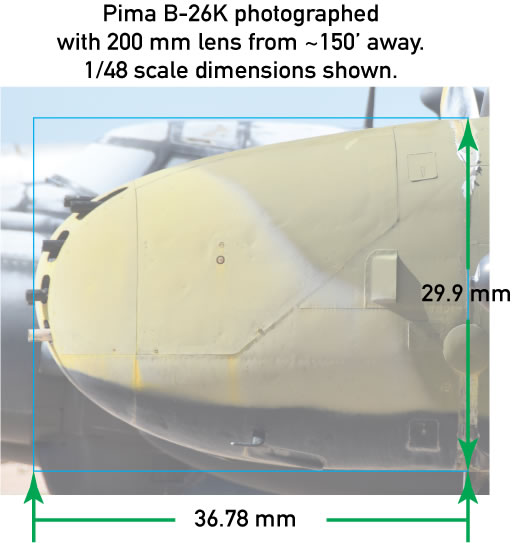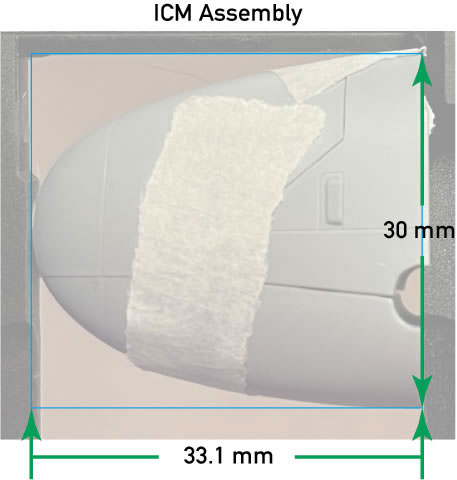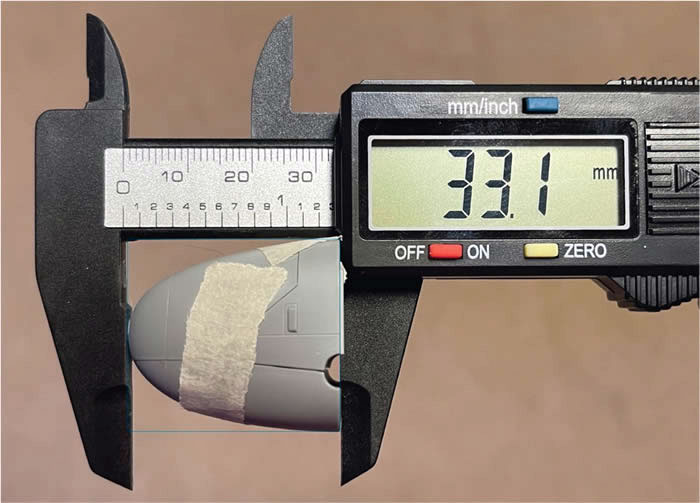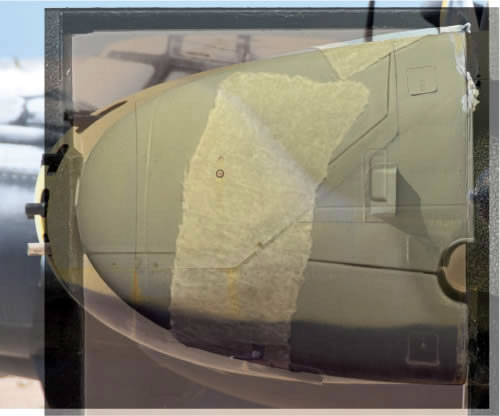ICM B-26K Invader:
An Analysis of 8-gun Nose Dimensions
by Jennings Heilig

Like many other modelers, I was overjoyed (and quite surprised) when ICM announced they were going to do a 1/48 On Mark B-26K Invader. ICM did their homework, and provided virtually a completely new kit. It shares some detail parts with the earlier B-26B/C kits, but you get entirely new fuselage halves, engine nacelles, props, wheels, and wings, all of which were required to account for the myriad differences between a WWII/Korean War vintage B-26B/C and the Vietnam era B-26K.
When the B-26K landed on my desk a few months ago, I did some rough assembly of the major components with masking tape just to eyeball the shapes and proportions. I had not purchased the earlier versions, so this was my first look at the kit. The poor old Invader seems to have been one of those airplanes that has a curse on it. No model company had ever seemed to be able to get the sleek, aggressive lines of the B-26 quite right. Arguably the most accurate kit shape-wise was the old 1950s box scale Monogram kit. Not really something for the serious modeler of the 21st Century however. The Airfix 1/72 kit from the 1960s just never looked right to me either, though I’ve never done any analysis of it, not being a 1/72 buy. In 1993 Monogram came along with their 1/48 B-26B/C kit. The instant I pulled that kit from the box I knew it was hopeless. I won’t go into all of its problems, but suffice to say they were very serious and very numerous, and the less said about that effort, the better. Even a former higher up at Monogram admitted to me privately that it was one of their worst efforts. When ICM announced their foray into 1/48 Invaders, the CAD images shown looked very promising. At last, it seemed someone had taken the time to really look at the Invader and to capture the “look and feel” of the airplane.
With the major B-26K airframe parts taped together, something about the nose didn’t seem quite right to me, though I couldn’t really put my finger on what it was. But the 8-gun nose, to my eye, had a pug-nosed look to it. It seemed to be a matter of the nose being too short, or possibly too tall, or possibly some combination of the two, throwing the proportions off, and missing that “look” so characteristic of the Invader’s gun nose. So I went on a hunt for data to see if I could unravel the mystery. My methodology is not to rely on anything anyone else has done as a reference or a starting point. Not to take anything away from anyone else or their efforts, but I wanted my analysis to be my analysis alone, for better or worse.
I am fortunate to have a collection of high-resolution scans of thousands of pages of Douglas factory engineering drawings of the B-26 in my collection. Unfortunately, they are not cataloged, and they seem to have been scanned in totally random order. Several evenings of very tedious work were required to finally locate the one drawing in the collection that contained the information I needed. I’m also fortunate to live in Tucson, Arizona, where the Pima Air & Space Museum has a B-26C and a B-26K on display. The Pima collection manager is a good friend and fellow modeler, and he’s very tolerant of my dragging ladders, rulers, T-squares, plumb bobs, and various other paraphernalia through the museum to measure his treasures. Thanks James!
On the real B-26, the horizontal reference point for the fuselage, known as Fuselage Station 0.00 (the point from which, using positive or negative dimensions, all horizontal locations of parts of the fuselage are measured) is located at the fuselage frame ahead of the cockpit where either the clear bomber nose or the various gun noses that Douglas designed for the aircraft are attached. There is a prominent panel line there (sometimes taped over, but still there), and the frame is perpendicular to the longitudinal axis of the aircraft. The Douglas engineering drawing I located showed a detailed view of the fuselage frame assembly at FS 0.00, looking aft. Fortunately, the high-resolution scan allowed me to see a number of dimensions called out on it, and thus to be able to scale the drawing down to 1/48 for comparison to the ICM kit parts. The drawing also shows the fuselage skin attached to the frame, providing the exact fuselage cross section shape at this location.
I have been out to Pima on several occasions to photograph and measure their two aircraft. Armed with a large T-square, level, step ladders, and camera equipment, and various other items, and with the enthusiastic and able assistance of several Tucson area modelers, I made a number of measurements. If you’ve ever tried to measure a real airplane - especially one that sits high up off the ground like the B-26, you know it’s a difficult task. We did some measurements on the glass-nosed B-26C that’s housed indoors (a blessing in the August heat of southern Arizona, I assure you!), since the FS 0.00 bulkhead is identical on all B-26s. Then outside to measure the 8-gun nose on the B-26K. Each measurement was done several times to try to get a good average. This is not a super precise way of doing things, but lacking any other definitive data (after an exhaustive search in the libraries of Pima, the National Air & Space Museum, and the folks in Texas who maintain and fly the B-26K “Special Kay”), it was the best we could do.
The engineering drawing allowed me to determine the vertical height of the fuselage at FS 0.00, so what I needed was the horizontal distance from there to the tip of the nose (my drawings collection are lacking any information on the gun nose), and that’s where my giant T-square came in. The square was placed parallel and level to the fuselage side and the distance from the tip of the nose to the FS 0.00 panel line was measured multiple times on both sides of the aircraft (just to be sure). Of ten different measurements made over three trips to the museum, five of them came within 1/16 of an inch of 69.5”, and the other five within a slightly bigger margin of that distance. Based on that, I’m pretty well convinced that the 8-gun nose on the B-26K is 69.5” long. There are numerous published references showing fuselage stations that show the forward tip of the gun nose as FS -63.0. I can’t explain why that would be the case, other than perhaps it was a typo, or possibly it represents one of the other gun noses and not the 8-gun nose fitted to most B-26Bs and B-26Ks. None of my measurements came out anywhere close to 63”.
While at Pima, I took the opportunity to photograph the nose area in as close as possible to a direct orthographic projection. The way to do that is to get as far away from it as possible, perpendicular to, and centered on the area you’re photographing, then pull the structure in with a telephoto lens. In my case, that was an 80-300 zoom lens attached to my Nikon DSLR. By using as long a telephoto lens as possible, the parallax error in the resulting image is reduced to the minimum. Since we live in a 3D world, there is no such thing as a perfect orthographic projection photograph, but you can reduce the error to a minimum with this method.
So as usual, I took the measurements, photographs, and the Douglas engineering drawing and set to work in Adobe Illustrator. I scaled the Douglas drawing down to 1/48 by taking the dimensions noted on it, making sure they matched in both X and Y axes. After that I carefully traced the outline of the fuselage skin indicated on the drawing to establish the actual fuselage cross section at FS 0.00. Here is the result of that operation.
Fig. 1

Then I carefully traced the outline of the ICM gun nose assembly with a sharp drafting pencil, scanned it at high resolution, and imported that into the Illustrator document, then traced the outline, establishing the cross section at FS 0.00 on the kit. The result is shown here. As you can see, the cross sections are different, especially at the top, but I don’t think these differences account for what my eye was perceiving on the length of the gun nose assembly.
Fig. 2

Next, I took my physically measured 69.5” nose length dimension and scaled it down, along with the previously established vertical dimension of 54.7” to get X-Y coordinates for the height and length of the gun nose. That comes out to 29.9 mm tall and 36.78 mm long. I cropped the gun nose from the best of my long telephoto shots of the Pima aircraft, scaling it down proportionally to see how it matched up. Here is the result:
Fig. 3

As you can see, the measurements I obtained from the Douglas engineering drawing and from measuring the X axis on the real B-26K are pretty much spot on the money. Note that I did not manipulate the photo in any way other than to proportionally scale it down to the scale dimensions I had calculated. It was not “stretched” or “pulled” in order to make it fit the dimensions shown.
Here are the actual B-26K dimensions scaled to 1/48 and converted (for sake of ease of measurement - I can’t think in 16ths and 32nds!) into millimeters.
Fig. 4

So now we move on to the ICM 8-gun nose assembly. Fortunately, the fit of the ICM parts is excellent. They were temporarily fixed together with masking tape, and the trusty digital caliper was used to measure the entire assembly (how did we get along without these things?). Here are my measurements of the ICM parts assembly:
Fig. 5

Fig. 6

Ah HA!! It all starts to become clear! While there is a very minor difference in the Y dimension (not enough to be concerned about), there is a significant difference in the X dimension. The 69.5” actual length of the nose scales out to 36.78 mm, and the kit’s assembly (after multiple measurements) comes out to 33.1. Now, if you say to yourself “Gee, 3.7 mm really isn’t much,” you’re right. To a point. But when we take into account the percentage of the error, it becomes much more significant, and it accounts for the reason the nose looks “pug” to me. In nice round numbers, there is a ten percent difference in length between ICM’s part and the actual aircraft. That’s the difference between (roughly) 1/48 scale and 1/43 scale. Here are the ICM and Douglas noses superimposed showing the difference.
Fig. 7

I’m hopeful that this analysis will prompt some enterprising aftermarket manufacturer to consider a new nose (as well as several other things the ICM kit could use). I’m happy to assist anyone with anything needed if it helps us get to the ultimate, accurate 1/48 B-26K!
Model, Images and Text Copyright ©
2021 by Jennings Heilig
Page Created 10 January, 2022
Last Updated
10 January, 2022
Back to HyperScale Main Page

|
Home
| What's New | Features | Gallery | Reviews | Reference | Resource Guides | Forum |